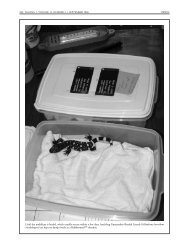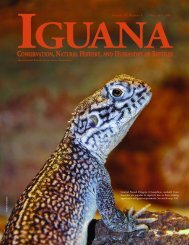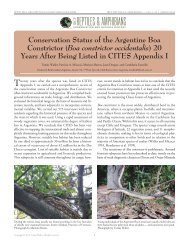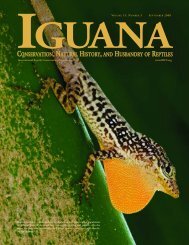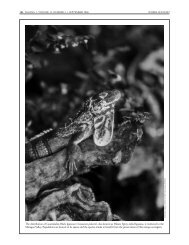Download
Download
Download
You also want an ePaper? Increase the reach of your titles
YUMPU automatically turns print PDFs into web optimized ePapers that Google loves.
CARILLE IRCF REPTILES & AMPHIBIANS • 19(2):117–125 • JUNE 2012<br />
Teeth of Solomon Islands Tree Boas (Candoia bibroni australis), like those<br />
of many boids, are capable of firmly holding and facilitating the swallowing<br />
of prey — and of delivering a painful bite.<br />
that small numbers of popular species should be imported,<br />
bred, and distributed. Whatever can be done to limit deaths,<br />
minimize parasitic infections, and increase the numbers of<br />
healthy, “tame” snakes in the trade is the best option. Snakes<br />
make great pets, but without conservation we cannot maintain<br />
viable wild populations. I would hate to see a species disappear<br />
from the wild because I wanted to put a snake in a<br />
tank just to admire it. That said, almost all available Candoia<br />
are wild-caught, are usually dehydrated, and many come<br />
infested with mites or other parasites.<br />
With the exception of C. aspera, Candoia are naturally<br />
calm, but you want to look for an individual that looks<br />
healthy and is active when held. You should try to buy your<br />
snake from a vendor that has some knowledge of the species<br />
rather than a person who can only tell you the country from<br />
which it was exported. As with all new snakes, they should be<br />
quarantined, rehydrated, and left alone until they acclimate.<br />
Once home, I’ll soak the snake in a water bath to rehydrate it.<br />
This means putting the snake in a Rubbermaid container for<br />
a few hours with a few inches of clean water and a branch on<br />
which it can climb. After rehydration, I hold new individuals<br />
in a separate room for two to four months, checking for mites<br />
and other illnesses (and treating them as necessary) before I<br />
merge them into the rest of my collection.<br />
Disposition.—Almost all Candoia are hesitant to bite, and<br />
if they do, it is only to determine what you are (i.e., to see if<br />
you’re tasty). Candoia b. australis rarely ever bites unless you<br />
are restraining it; C. carinata will bite for the same reason, but<br />
is so small that it can barely bite a pinky finger; C. b. bibroni<br />
and C. paulsoni will bite when unsettled, but most will sit still<br />
for a cage cleaning as long as they are not moved too much.<br />
Contrary to all the other species of Candoia, C. aspera can be<br />
downright mean. They are by far the Candoia most inclined<br />
to bite. However, as with all snakes, captive-bred individuals<br />
will almost always be more docile than individuals that<br />
are wild-caught, and even the latter can be calmed if handled<br />
frequently and gently.<br />
122<br />
Morphs.—Until the end of 2011, no Candoia morphs<br />
were known (other than a single leucistic C. paulsoni with<br />
which Jerry Conway had been working). Recently, several<br />
albino projects have popped up. Albinos Unlimited, Inc.<br />
announced the importation of a wild-caught albino C. aspera.<br />
If all goes well (and if the trait proves to be recessive), albinos<br />
should enter the hobby within the next couple of years.<br />
Another private hobbyist is currently working with possible<br />
het albino Isabel Island Ground Boas (C. paulsoni) and<br />
hypomelanistic Candoia sp. Still another private hobbyist<br />
is working on producing calico C. aspera from a dark male<br />
with random orange and white splotches. Lastly, although I<br />
am not aware of any proven lines of hypos, some hypo C.<br />
carinata, C. aspera, and C. b. australis are floating around in<br />
private collections.<br />
This rather elaborate enclosure is home to several Solomon Islands Tree<br />
Boas (Candoia bibroni australis). It consists of a 40-gallon breeder tank<br />
turned upright and equipped with climbing vines, a birdhouse with fake<br />
vines as a makeshift hide and hangout, climbing mesh, a big water bowl,<br />
and tropical sphagnum and peat substrate to help maintain humidity.<br />
Temperature and humidity are more difficult to control in such a large<br />
container and need to be carefully monitored.



